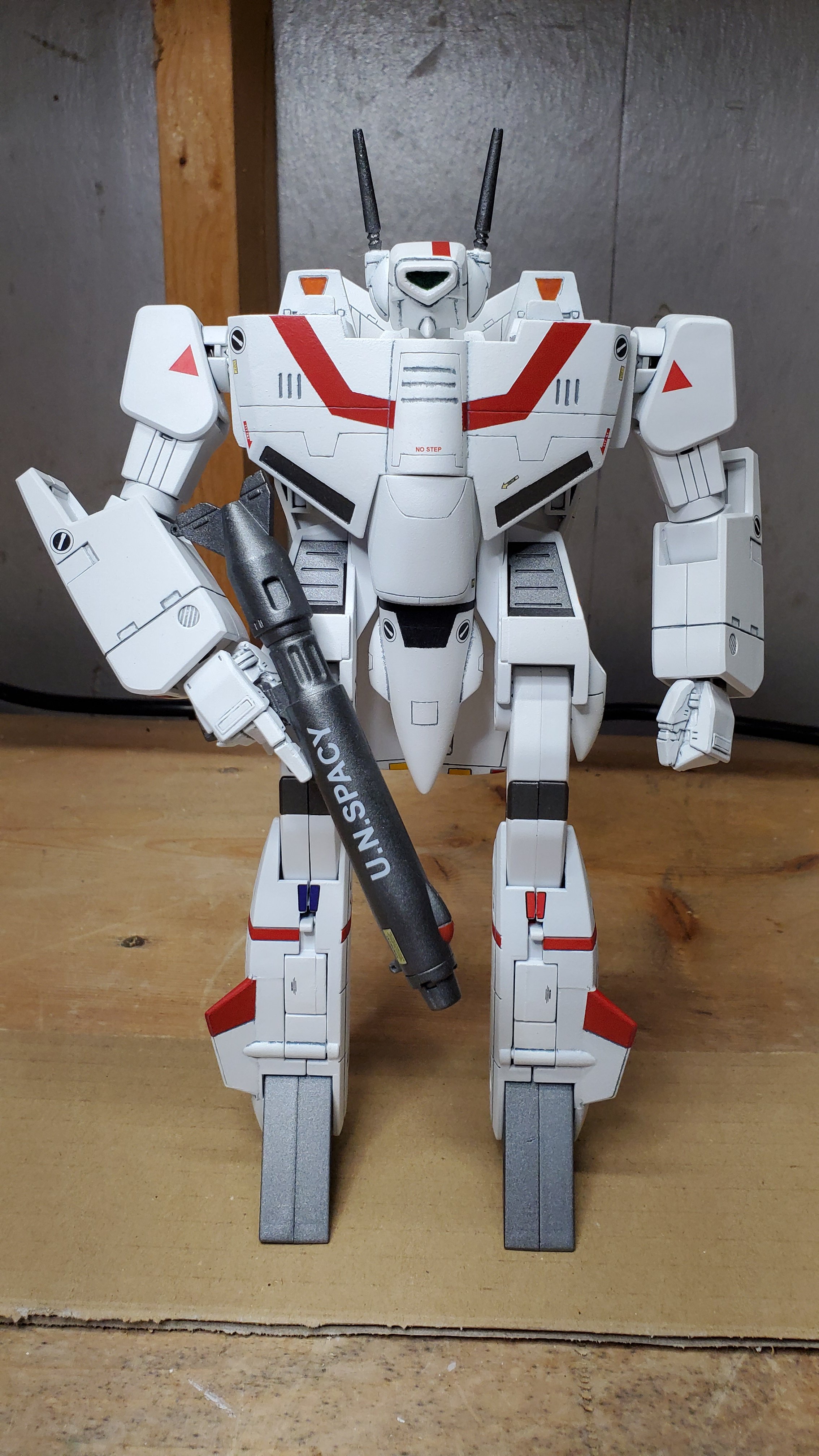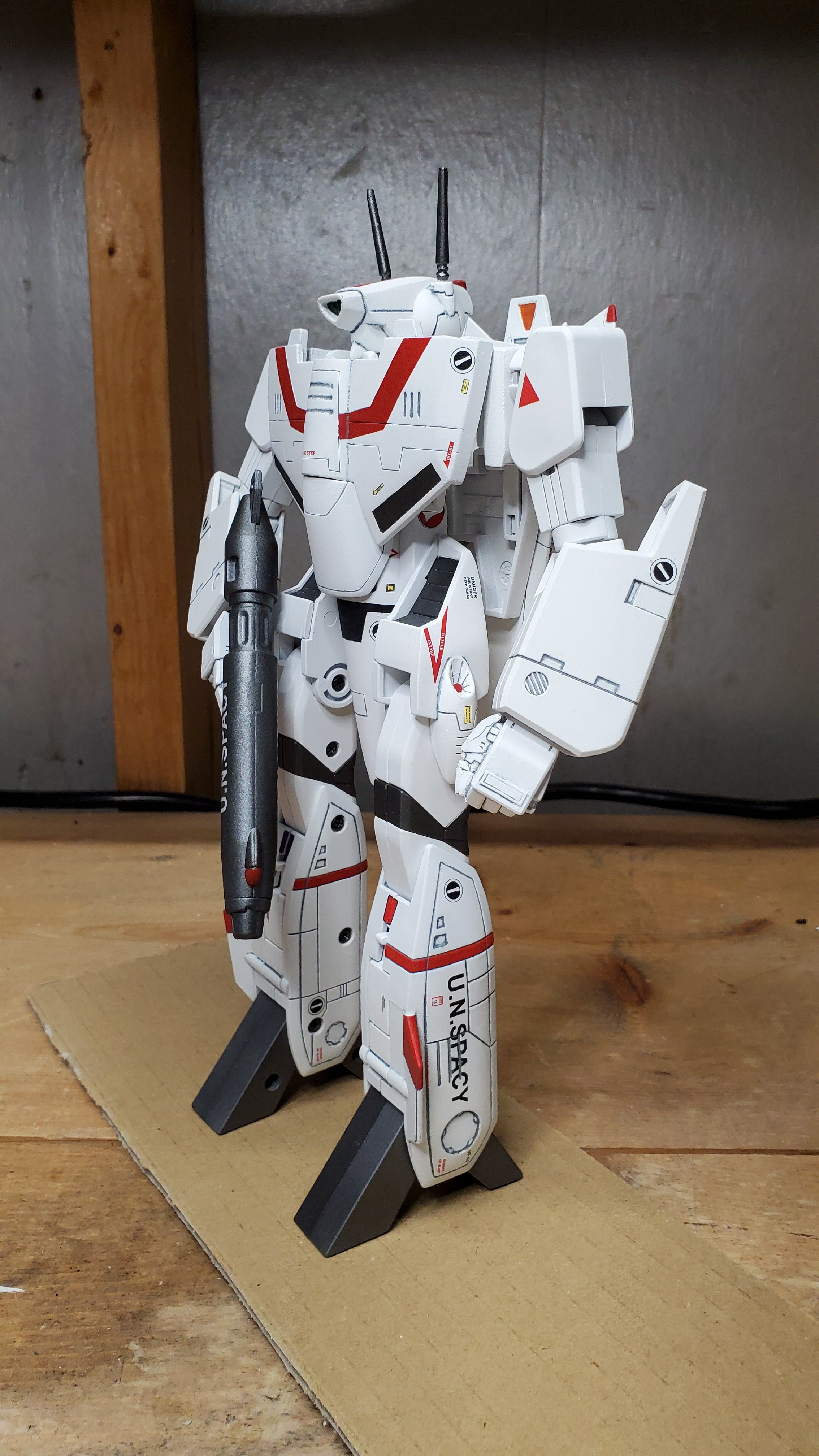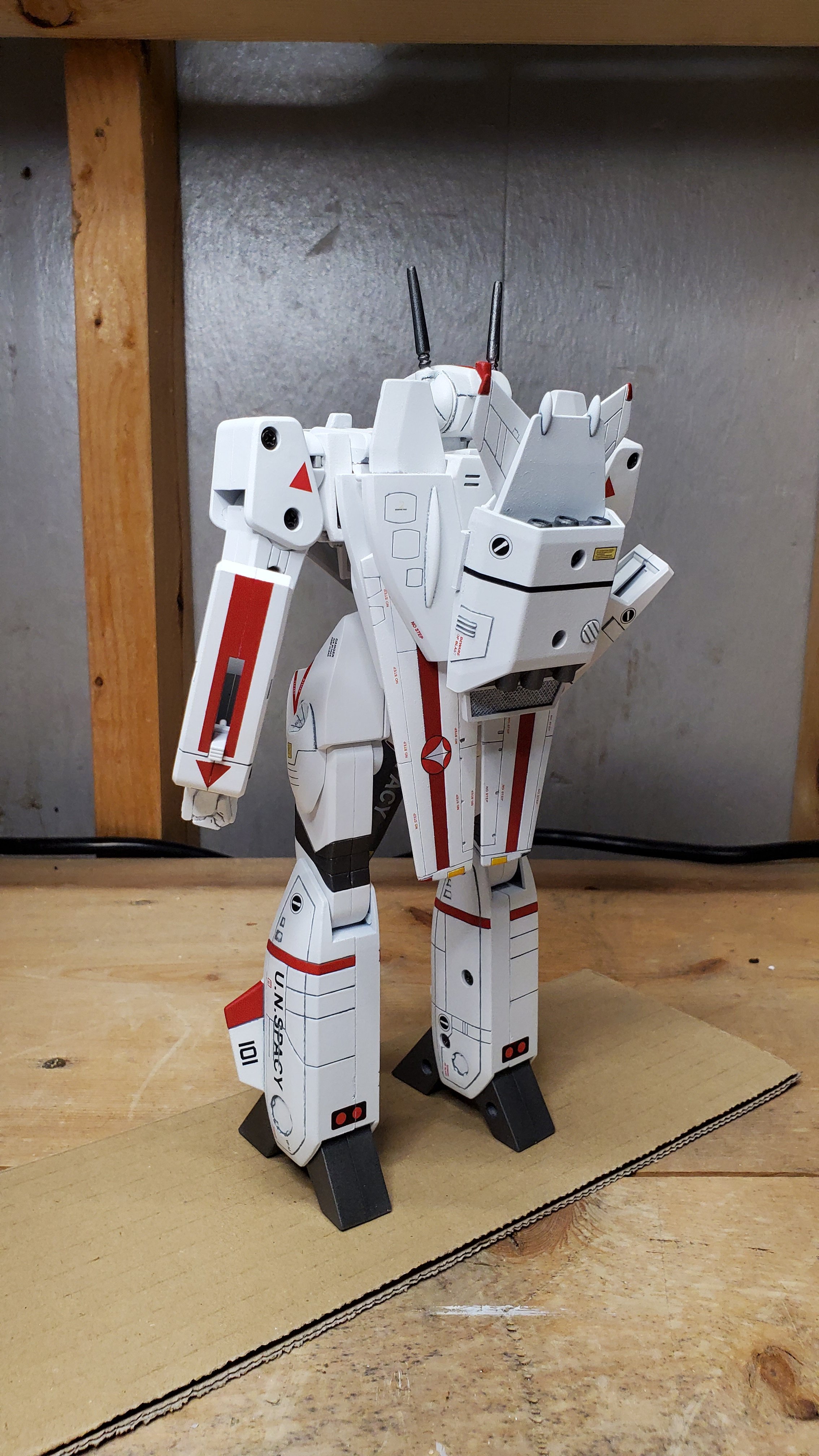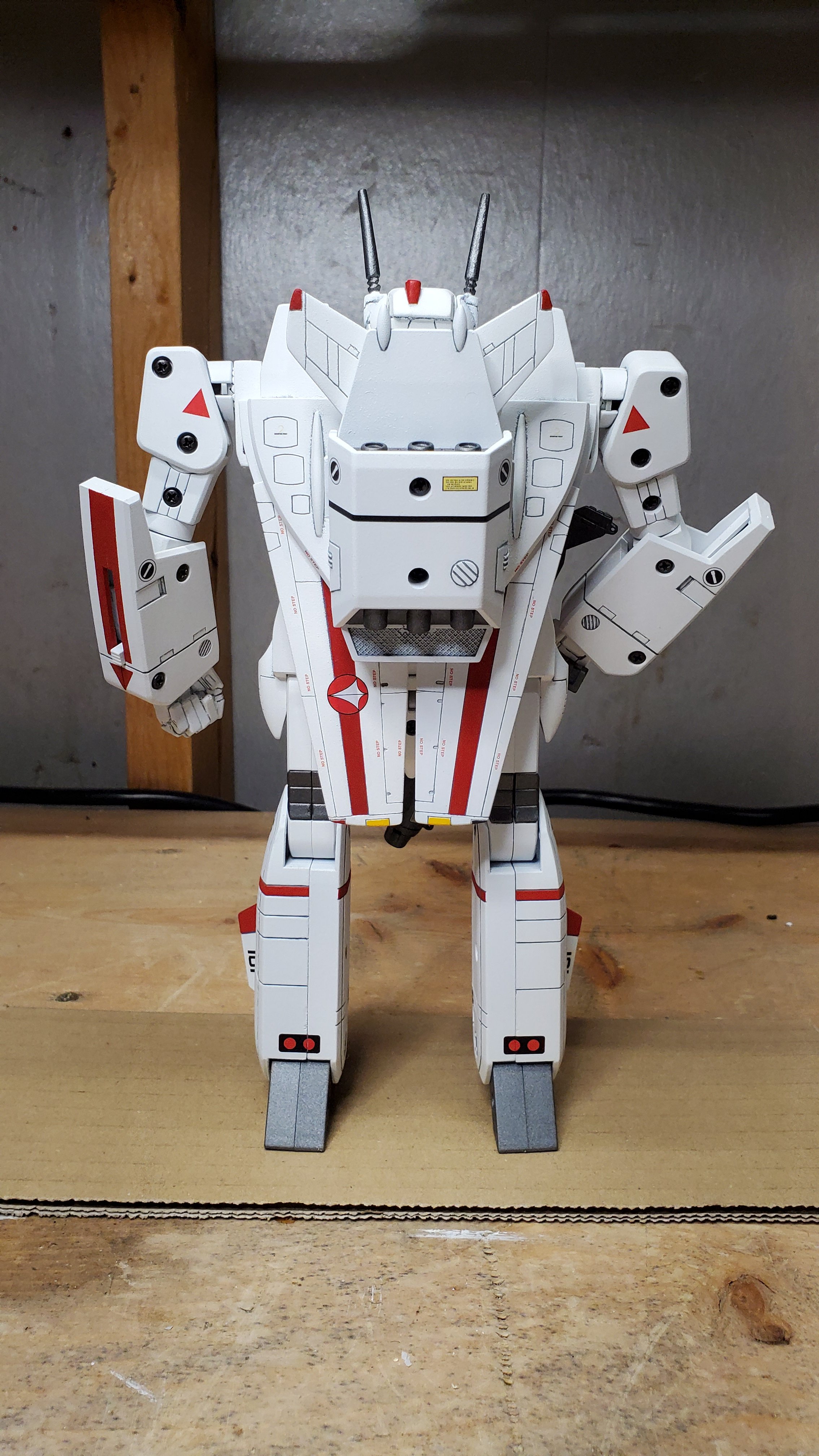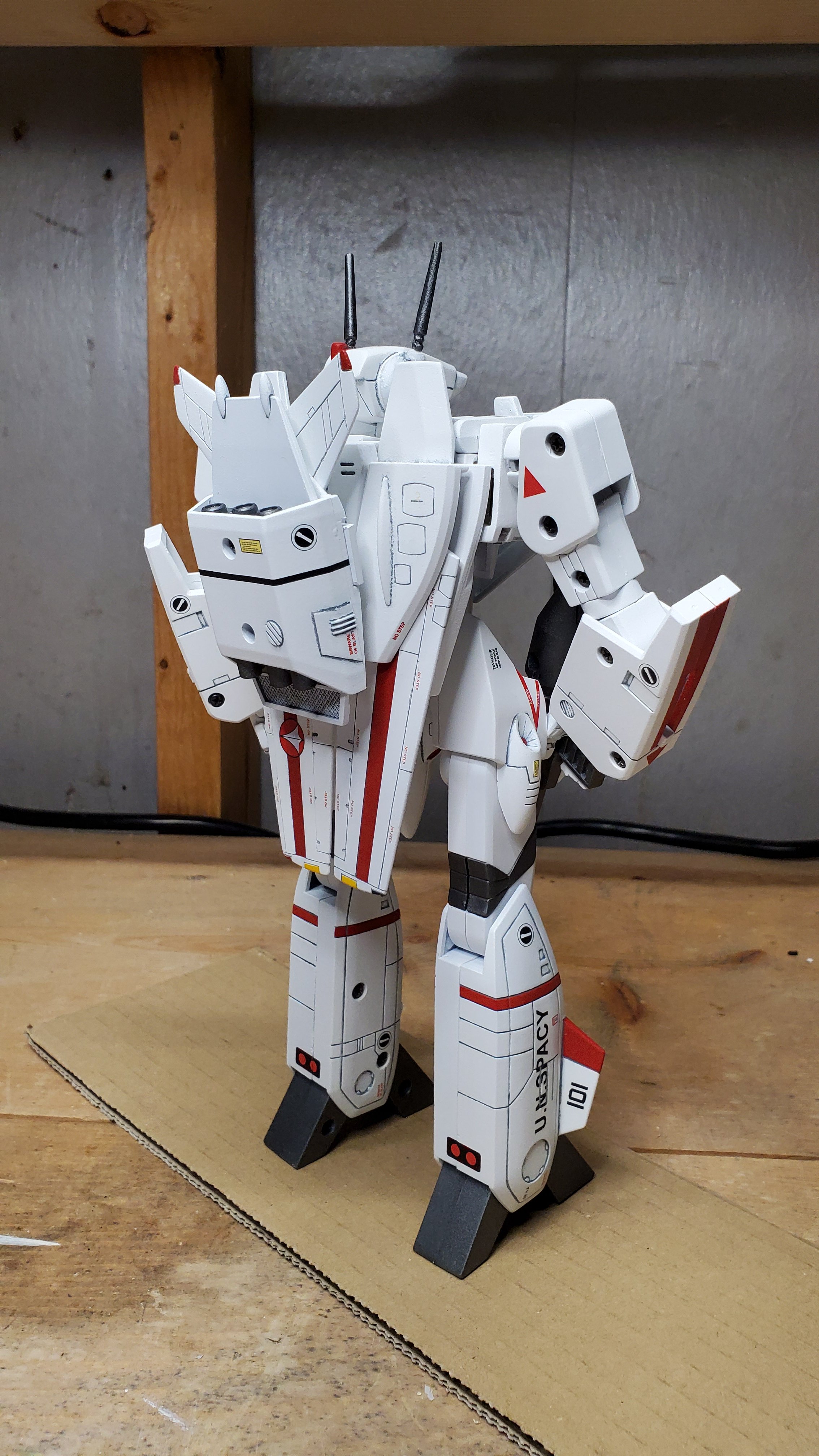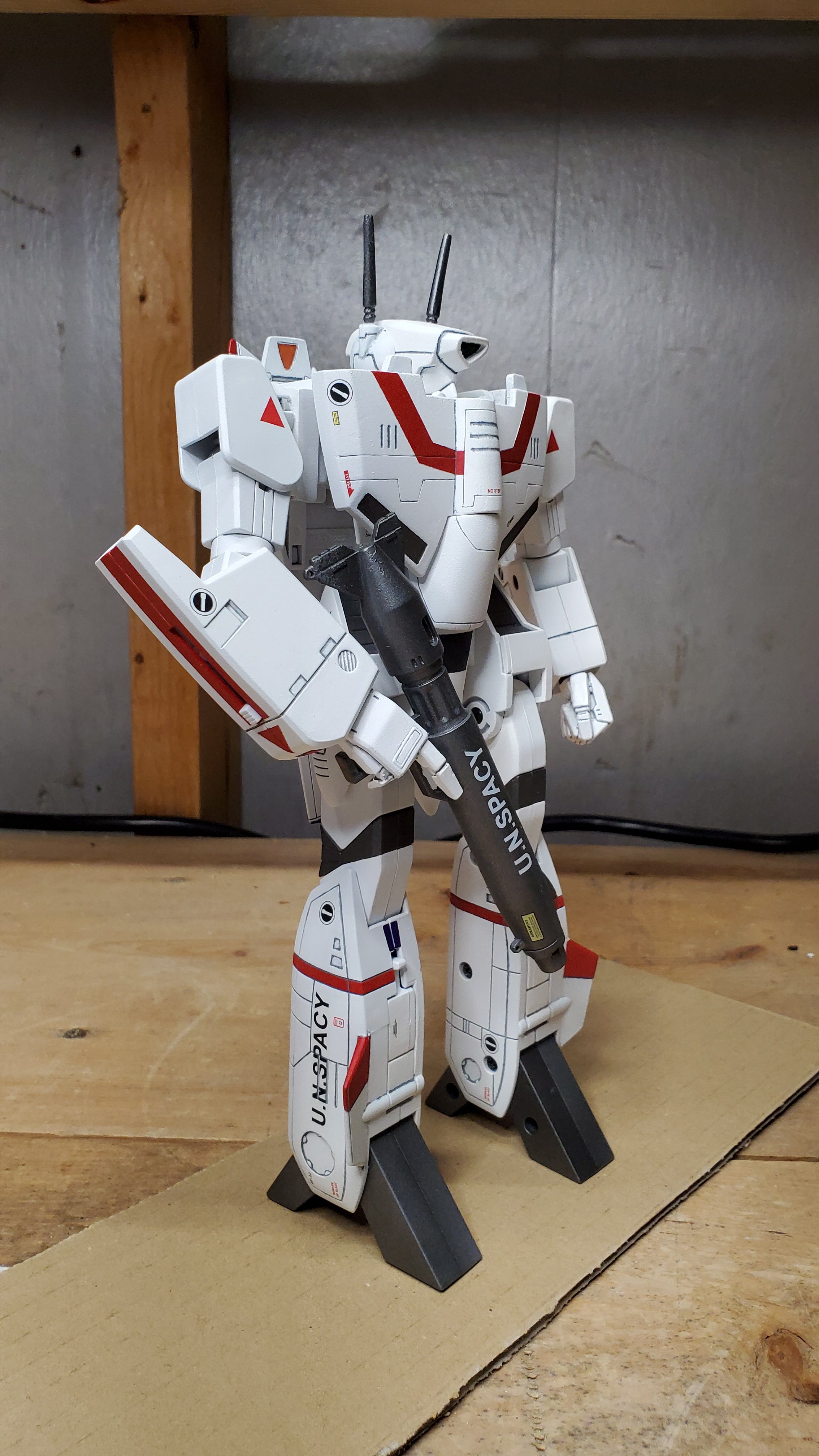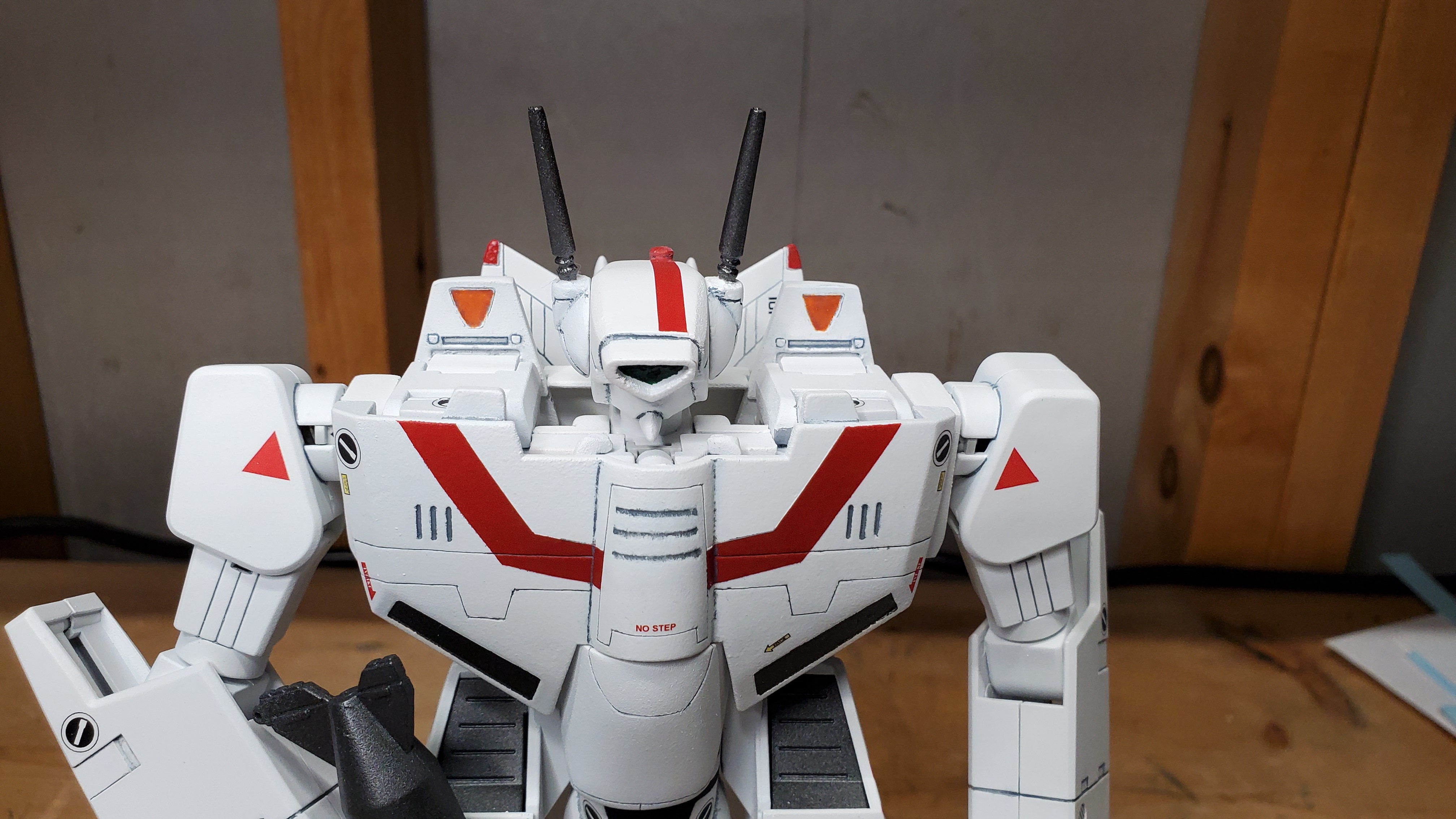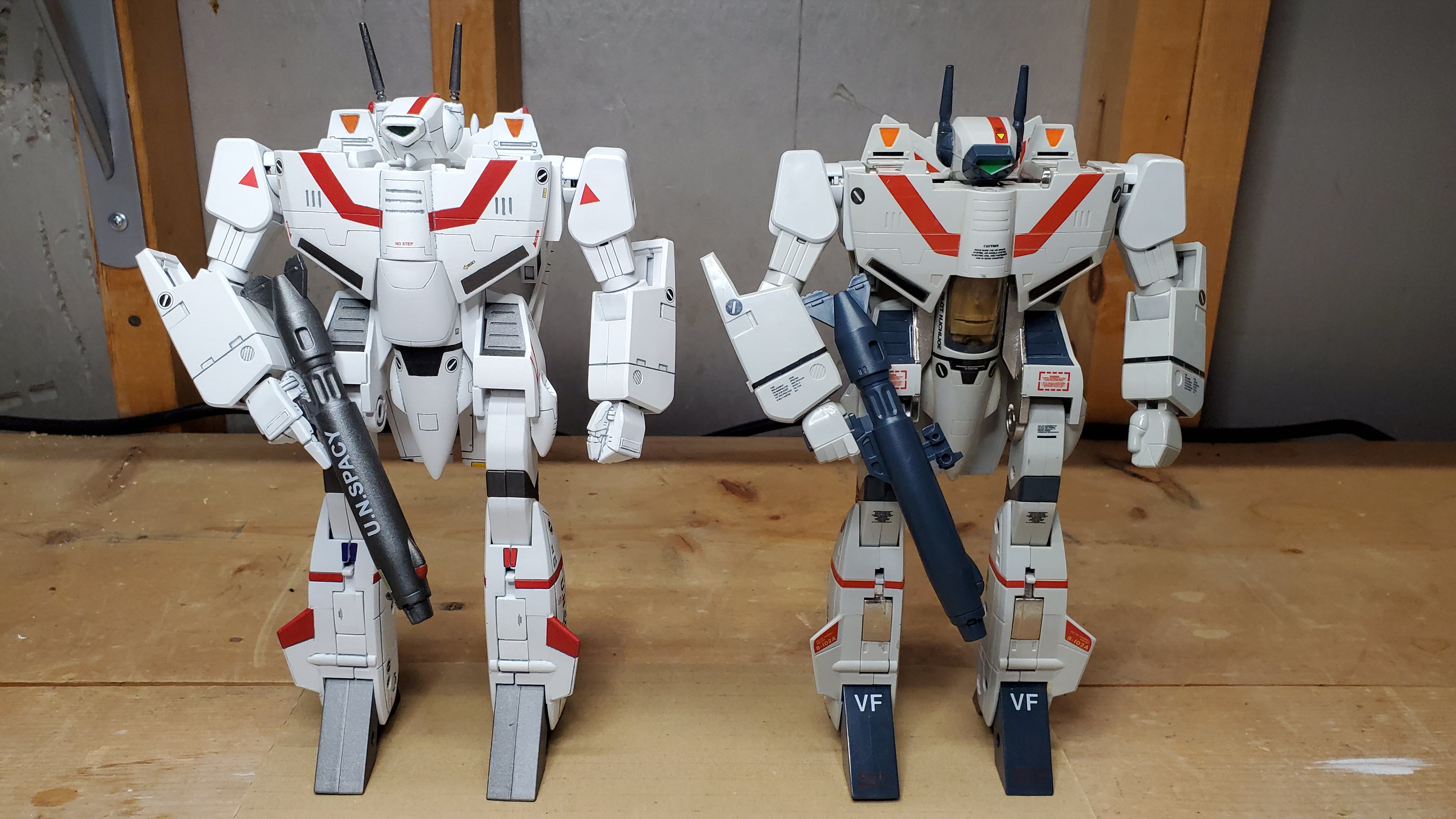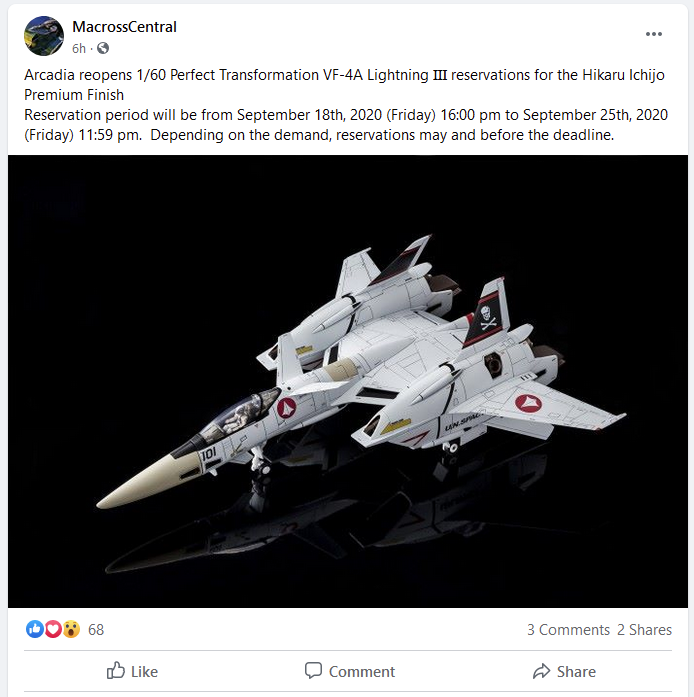-
Posts
2060 -
Joined
-
Last visited
Content Type
Profiles
Forums
Events
Gallery
Everything posted by Anasazi37
-
I bet you have a nice collection of those--can't wait to see it! Thank you! It feels really nice to be spending time at the workbench again, especially with how crazy the world is right now. The 1/55 part of my collection has been a big gap because I kept wanting to fill it with customs. Now there's one on the shelf and more on the way!
-
^^^ Fixed your post for you. And thank you.
-
Before the Bandai 1/48 DX and 1/100 HM/HMR lines, the Arcadia 1/60 line, and the Yamato 1/48 and 1/60 lines, there was only the 1/55: the Chunky Monkey. Not long after I joined MW in 2001, I started seeing all of the awe-inspiring 1/55 customization work happening and wanted to try it myself. I bought some beat-up Jetfires on eBay and started acquiring resin parts so I could recreate the entire original lineup of Takatoku and Bandai valks, because the alternative was to spend A LOT of money trying to track down rare ones like the Super Ostrich, Elintseeker, and VF-1S Strike. Plus, I thought it would be fun to do something this challenging and creative. I continued acquiring parts and eventually got my hands on a dozen Bandai reissue valks so I'd have enough to recreate the lineup, plus a few more variants that were never made. That's actually the origin story for all of the decal work I've done for this community: I needed decals for my own 1/55 customs. Printing decals for MW members quickly ate up my available hobby time, as did working on Yamato 1/60 and 1/48 customs for members. I put my own customs on hold, promising myself that I'd get back to them soon. Life interfered, as did work, and suddenly it's the fall of 2019 and I have no customs of my own. So, I kicked off a project to complete the entire lineup and the first one is finally done (see pictures below). As I complete the others, I will post pictures of them here. I have thirteen planned: VF-1J Hikaru VF-1J Max VF-1J Milia VF-1A Cannon Fodder VF-1A Max TV VF-1A Hayao TV VF-1D VF-1S Roy Strike (I prefer it to the Hikaru and having a TV Roy as well seemed redundant) VT-1 Super Ostrich VE-1 Elintseeker VF-1S Blue Roses 002 Strike VF-1S Minmay Guard Paris Act VF-1J Hikaru with GBP Part of my reason for making all of them is to work on, and finish, a project that has a lot of meaning for me. Another part is to show the 1/55 some love, making it look its absolute best. I have some crazy-fun, super-rare resin parts that I'll be using to help with that, like a highly-detailed custom nosecone with a canopy that opens and a DYRL pilot in the cockpit. This first custom took almost a year to complete because I had to rebuild my entire workshop, relearn a huge amount of customizing skills (and pick up some new ones), and repair a lot of damage to the custom I decided to start with. I began that one a very long time ago, before I had any idea what I was doing, and it showed. So I stripped it down and started over. I'm hoping to complete one every month or two, so this project could take a few years. I hope you enjoy these customs. The first custom is an iconic one: the Hikaru VF-1J. I spent months fixing all sorts of mistakes I made all those years ago, which included rescribing a bunch of panel lines, filling holes, and doing a complete repaint. The head is from Rob Beers, the heatshield is from Chris Barretta, hands are recast 1/48 Yamato GBP. The hands are swappable with the originals and attached using a Kotobukiya ball joint system. Gunpod was modified (I removed the gunsight). Decals, which look painted on, are of course my own designs. The chest stripe is also my own design, which is an attempt to honor the original line art within the confines of what can be done with the part. I used a Hasegawa chestplate as a reference and ended up creating a paint mask in Adobe Illustrator that I could run through my vinyl cutter. Beats using masking tape and trying to eyeball the stripes. Could I transform this? Yes. Would I? No. Turns out the tolerances on the swing bar were too tight and there's some nasty paint scrape on the midsection of the nosecone, so this bad boy is staying in battroid mode. He's eventually going to end up in customized GBP armor, so that's okay. I need to find a solution for the swing bar problem before I start on my next one. Last picture is a before/after. This custom started out life as a Hikaru 1J reissue. I thought that was fitting.
-
I finally had the opportunity to use the bottle of KiKi that I ordered. Worked great on my Yamato SV-51 Ivanov. The wings were a floppy mess in Gerwalk mode and this stuff tightened them up so well that I can now attach all of the armaments and the boosters and display them with the outer portion of each wing horizontal, which looks way nicer. The weight of the attachments and the loose hinges made that impossible to do before. Now to fix my 1/48 VF-1J Hikaru. When you put him in GBP armor, he has a hard time staying upright unless you balance everything perfectly.
-
I wonder where those decals came from If you go back a few pages in this thread and start reading from there, you'll quickly see how big of a dumpster fire NY has become with respect to orders for Strike/Super Parts sets. In short, their recent responses to shipping requests have been to offer store credit because they don't have any sets on hand and don't anticipate receiving more. They're claiming that one of their suppliers fell through. Rather than saying that to everyone with open orders, you only find out if you contact them, which means they'd likely hang onto your money indefinitely if you weren't proactive. Another member defined that as theft. It sounds like you've tried contacting them several times and they still aren't responding, which is taking their already-terrible customer service to a new low. You should be able to get your money back from your card issuer, but NY will likely ban you after that and PayPal might not be too happy, either. I'm not discouraging you from going that route because I'd do exactly the same thing. It's why I always use a card through PayPal for long-lead-time preorders where I have to pay in advance. The additional protection helps when you end up outside PayPal's six-month window. Members are also reporting issues with NY store credit. You have to use the entire thing in one shot, so if you apply it to another purchase and there is money left over, you lose it. That could also be defined as theft.
-

Please post Bugs and Forum Feedback here
Anasazi37 replied to Shawn's topic in MW Site News & Member Feedback
I'm having exactly the same problem. It's been at least a week since I've received any notifications (messages, mentions, posts in subscribed threads, the works). First time it's happened to me since I joined MW in 2000/2001. -
We also love getting the last word
-
- 1113 replies
-
- 1
-

-
- vf-4 lightning iii
- arcadia
-
(and 5 more)
Tagged with:
-
Was that the Roy displayed with the Scout?
-
Odds are very low. To my knowledge, they haven't reissued anything so far and whether or not the line will continue is an open question. They have done non-canon variants of previous releases, like the Roy VF-4 and the Messer VF-1S, so maybe they'd go back and reissue some stuff because they already have the molds, but I'm not holding my breath. We're all waiting to see what, if anything, Bandai displays at their annual fall Tamashii Nations event in early November. The last HMRs displayed at a Tamashii event were a Regult Scout paired with a Roy 1S. No release date was mentioned. Prior to that, we saw the standard VF-4 (Hikaru) and blue/red Max/Milia variants displayed. Hikaru was released, Max and Milia were not (so far). I'm pretty sure that the VF-1D release came out of nowhere.
-
I assume he has five of each: one to display in each mode, a MISB backup in storage, and a MISB backup for that backup. The ones in storage are probably encased in carbonite.
-
And those are probably just @tekering's extras....
-
Yeah, that's where I was thinking they could go without being a distraction. Good to see that two full rows fit in that space. I'll be adding basic kill markings to the next version of my set, but could also make them available as a separate set with more options.
-
Best place to check for updates is this page, under the "Notifications on International Mail" section: https://www.post.japanpost.jp/index_en.html Latest update is from 10 Sep. Nothing mentioned about the US. The master status list for all countries is here: https://www.post.japanpost.jp/int/information/overview_en.html I doubt that there will be any change in status for the US until there are more commercial flights coming here from Japan (EMS and SAL hitch rides on those flights). All the usual online stores will probably post the news before we see an official update on the English language JP site. It seems to lag behind the Japanese language site by a day or two.
-
That's exactly why I posted the picture. I noticed Roy in the cockpit, ready for atmospheric flight. Bandai could easily solve the problem by including an extra Roy wearing his space flight helmet, but no....
-
Good point! I missed that additional party foul. No air intakes necessary in space.
-
Agreed, it's not just about UV light. If you have the means, ability, and interest to mitigate it as one of causes, it will help to reduce the odds of yellowing, but there's the nature of the plastic itself and also the atmosphere to contend with, as you say. Oxygen, humidity, temperature, etc. Altitude also has an effect. I live at 6300 feet in a desert, so there's less oxygen and humidity up here, but also less atmosphere, meaning more natural UV gets through. Right now all of my Macross stuff is displayed on open shelves in a room that doesn't get direct sunlight, plus I keep the curtains closed. Good enough for me. I might upgrade to glass cases at some point because dusting my collection is really annoying.
-
Okay, that's both disturbing and funny. Based on your previous post, it sounds like you have a UV radiometer/light meter with the following specs: The display is in µW/cm2 (microwatts per square centimeter) UV AB Measurement Range: 0 to 2999 µW/cm2; It only measures UV AB light power output, but not the wavelength. Spectral Detection Range: 240 to 370 nm; Peak point: 352 nm. It does not measure UVC. Measurement accuracy: ±4% ±1 digits; Resolution:1.0 µW/cm2 Unless a bulb manufacturer gives you information about the amount of UV light the bulb is sending out, you'll have to make a direct measurement. The specs for the meter claim that it's accurate to within 4%, so you could take the reading you get and create a range for your bulb, with your reading minus 4% on the low end and your reading plus 4% on the high end. And you're getting a more general estimate for all of UVA/B, what is sometimes called an integrated value or a band pass value. The sensor gathers in light across a broader range of wavelengths and then averages all of that to produce a single value, so any specific behavior of UV light at specific wavelengths is lost. That's why lab-grade spectrometers cost so much. Not only are they calibrated, but they also make multiple measurements over smaller chunks of the range, sometimes hundreds or thousands of them, which can then be used to create a continuous line that looks something like this, which I randomly grabbed from the results of a Google Image Search: So, back to your question about how much UV light is too much and can you convert the output from your UV meter into something useful. I would argue that µW/cm2 is a useful measurement because it's absolute and describes how much energy is hitting a surface, which is exactly what you want to know. The technical term for it is irradiance: https://en.wikipedia.org/wiki/Irradiance Irradiance is widely used in the scientific and engineering communities, so you're on solid ground there. So, I think it's more about taking values used by communities who worry about UV light damaging stuff and converting them to irradiance, but let's put a pin and that in see what they actually do. It does seem like the cultural heritage preservation crowd, i.e., museums, has thought about this quite a bit. I found what looks to be a pretty useful resource from the Canadian Conservation Institute (likely far more credible than a random reply on a message board): https://www.canada.ca/content/dam/cci-icc/documents/services/conservation-preservation-publications/canadian-conservation-institute-notes/2-2-eng.pdf It opens by saying that no one outside of the museum world thinks about UV in relative terms, which is what that µW/lumen measurement is: a ratio between light you can't see and light you can. Hence my previous comment about how you can't take a visible spectrum, lumens-only measurement and convert it to one that is relevant for UV, however if you have instruments that can measure both (I forgot you had both), you can create your own µW/lumen measurement. There's an entire section in the article on absolute UV values, which was nice to see. Probably a hat tip to radiometry nerds like me. Based on that article, it does seem like 10-75µW/lumen is the acceptable range, even if the approach is wacky. What matters is that museums have been using this approach for a long time and the numbers hold up, so make use of the numbers. Let's do some math: 1 Lux = 1 lumen/m2 1 m2 = 10000 cm2 Visible light meter reads 4600 lux UV meter reads 12 µW/cm2 The equation given in the paper looks like this: UVab = (L x UVr) / 1000, where UVab is reported as mW/m2, but those aren't the units we want. So, this is what you do: µW/cm2 = (lumen/m2 * μW/lumen) / 10000 So, you end up with 12 = (4600 * UVr) / 10000, where UVr = 26.09 µW/lumen A value of 26 is in the acceptable range, so my best guesstimate is that your bulbs are fine.
-
You could definitely do that. The female figure is a bit more slender, but if you painted it as Hikaru, I don't know if anyone would notice the difference unless you pointed it out. He is shorter and skinnier than Roy, after all. I just couldn't bring myself to do that to him, plus having a second set as backup in case I somehow screw up the first one seemed like a good idea. I'll probably pick up a third set in case I need to make my own space flight Max and Milia pilots, because I'm holding out hope that Bandai will release their 1Js at some point and include or at least offer Super Parts for them, but I'm assuming they'll make a bad non-canon design choice and only give us atmospheric flight pilots (even though a space flight pilot comes with the Max 1A TV). For as small as the figures are, the level of detail on the 3D printing is really nice. As @Xigfrid says on the site, you might have to do a little sanding here and there, but otherwise they're ready to paint. I don't normally paint miniatures and yes, it's a major pain in the backside. I remember doing it, and not enjoying it, when I was making 1/48 and 1/60 Yamato customs for folks here. I'll probably start on my Roy and Hikaru figures next month so I can have them ready for the release at the end of November. They will take time and I'm sure I'll make a bunch of mistakes that I'll have to fix.
-
Bandai just put a Roy on display in Akihabara with the Super Parts *and* atmospheric-flight-helmet-Roy in the cockpit. How very non-canon of them. I've already picked up two of @Xigfrid's DX pilot sets on Shapeways so I can have both Roy and Hikaru in space flight helmets: https://www.shapeways.com/product/G8D52LFAX/pilots-set-for-vf-1j-dx?optionId=91611789&li=shops
-
Keep in mind that lumen, as a unit of measurement, is for the visible portion of the spectrum (roughly 400-700 nanometers). UV is outside of that range (100-400 nanometers). In other words, the radiometer is measuring transmitted light in one part of the spectrum and you have a manufacturer's estimate for light transmitted by a bulb in another part. The values don't overlap, so you can't combine them in this way. Not that I ever thought I'd be posting a picture of the electromagnetic spectrum in this forum, but the following shows you why it won't work (UV is to the left of Visible) This is a crude analogy, but it's like you have an estimate of engine performance in one set of units that is specific to driving between 40 and 70 mph, but what you really want is an estimate for between 10 and 40 mph in another set of units, so you're doing the unit conversion and trying to use the estimate you have, but the engine is highly likely to perform differently in the other range and, more importantly, you have no actual data in that range. To do the math you want to do, you'd need a lumen number specific to UV...which doesn't exist...because lumen is for the visible portion of the spectrum...so you really need a UV radiometer. On top of everything else, lumen isn't an absolute measurement, like the radiance measured by a radiometer. How the human eye sees that light is accounted for in the value using a subjective model (luminosity function), so scientists don't like it, but it seems to make sense to consumers. The wavelength limitation and subjectivity of lumen is mentioned in the first few sentences of its Wikipedia article, although if you're not familiar with radiometry, it's super-easy to miss the significance: https://en.wikipedia.org/wiki/Lumen_(unit)
-
You forgot to add "launch container into space"
-
-
The yellowing on the landing gear doors (and the missiles) is a known issue on the v1 TRU-exclusive VF-1A CF. I didn't know about the issue until I pulled mine out of its box for the first time earlier this year. I bought it in early 2002 and it was in dark, temperature-controlled storage the entire time. Only the doors and the missiles were yellow--that exact sickly shade of yellow--and there was an awful smell. I think the plastic outgassed over the years and changed color during the process. UV might accelerate that process. I ended up re-boxing my TRU and picking up the non-exclusive CF that was released a few months later. Everything is bright white on that one.

